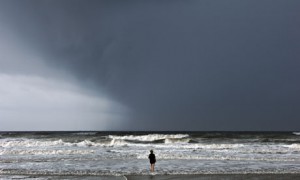Preparing Communities for Sea Level Rises
 January 19, 2017 – New U.S. regional sea level scenarios developed by NOAA and its partners will give coastal communities better, more localized data to help them plan for and adapt to the risk of rising sea levels to their economies and infrastructure.
January 19, 2017 – New U.S. regional sea level scenarios developed by NOAA and its partners will give coastal communities better, more localized data to help them plan for and adapt to the risk of rising sea levels to their economies and infrastructure.
Sea level rise is occurring worldwide, but not at the same rate everywhere. Differences will also likely continue in the future, so decision-makers need local information to assess their community’s vulnerability.
These new scenarios integrate updated global sea level rise scenarios with regional factors, such as changes in land elevations and ocean circulation, that influence sea level regionally.
“The ocean is not rising like water would in a bathtub”
“The ocean is not rising like water would in a bathtub,” said William Sweet, Ph.D., a NOAA oceanographer and lead author of the report detailing the scenarios.
“For example, in some scenarios sea levels in the Pacific Northwest are expected to rise slower than the global average, but in the Northeast they are expected to rise faster. These scenarios will help communities better understand local trends and make decisions about adaptation that are best for them.
In the report, the researchers relied on the latest published and peer reviewed science to refine six global sea level rise scenarios (Low, Intermediate Low, Intermediate, Intermediate High, High, and Extreme) decade by decade for this century.
The report helps communities track a range of scenarios that they may fall under for each of the timeframes, and assess their risk of experiencing impacts under the scenario.
The researchers scaled these scenarios down to a one-degree gridded resolution, or roughly 70 miles. This allows a coastal manager in Miami and one in Mobile, Alabama, using the same scenario to prepare for different outcomes.
A similar method is already being used in state planning in the mid-Atlantic and Gulf of Mexico and has been previously used to assess risk to worldwide U.S. military installations in an interagency report prepared for the Department of Defense in 2016offsite link.
A joint public- and private-sector group developed the report for the Sea Level Rise and Coastal Flood Hazard Scenarios and Tools Interagency Task Force, which was convened by the U.S. Global Change Research Program and National Ocean Council in 2015.
Researchers from NOAA, Rutgers University, the Environmental Protection Agency, South Florida Water Management District, Columbia University, and U.S. Geological Survey co-authored the report.



